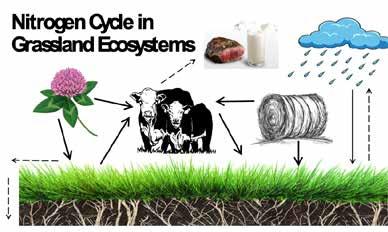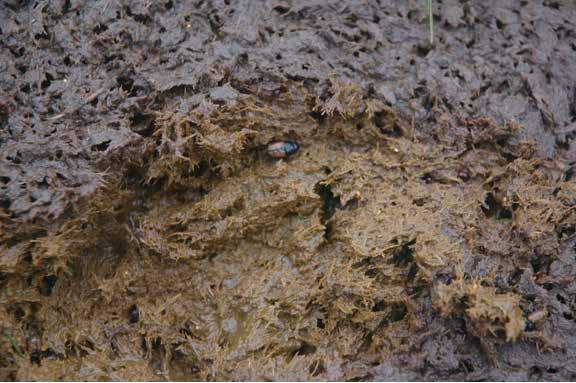
7 minute read
Chris Teutsch: Nitrogen Cycling in Grassland Ecosystems: The Spotlight is on Clover
Nitrogen Cycling in Grassland Ecosystems: The Spotlight is on Clover!
Chris Teutsch Univerity of Kentucky Grain and Forage Center of Excellence, Princeton, Kentucky
Since we visited last month, nitrogen price has continued to increase. In the past 12 months nitrogen cost has more than doubled (Figure 1). Currently, urea is priced at $750 /ton or $0.82/ lb N. Even so, nitrogen remains an important part of grassland ecosystems and is closely related to both dry matter yield and crude protein concentrations in grasses and non-leguminous forbs. Since nitrogen is highly mobile in the soil, soil testing is not commonly used to make nitrogen fertilization recommendations. Recommendations are based on research trials conducted over multiple years and locations.
NITROGEN CYCLING IN GRASSLAND ECOSYSTEMS
So here is some good news…in well managed grasslands strong nitrogen cycles can be developed over time. Nitrogen enters these systems in the form atmospheric deposition (minor amounts), feed and supplements brought into the system, and nitrogen fixed by legumes. These cycles can reduce or in some cases even eliminate the need for nitrogen fertilizer. It is important to realize that these cycles take time to develop require good grazing and feed management. A key component of these cycles is the use of legumes such as red and white clover and alfalfa (Figure 2). Legumes fix nitrogen in the air to a plant available form. The importance of legumes in grasslands has long been recognized. They bring nitrogen into grassland ecosystems via symbiotic nitrogen fixation, improve forage quality and animal performance, and dilute the toxic effects of the endophyte found in tall fescue. It is estimated that commonly used pasture legumes will fix between 50 and 250 lb of nitrogen per acre per year (Table 1). At current prices, the value of this nitrogen is between $40 and 200 per acre per year. Legumes share nitrogen with grass indirectly. Nitrogen is transferred to grass grown in association with legumes through the ingestion of legumes and subsequent deposition of dung and urine by grazing animals (Figure 3), death and decomposition of above and below ground plant parts including roots, shoots, and
Figure 1. Nitrogen price trends over the last 12 months. Data are from DTN and available at https://www.dtnpf.com/agriculture/web/ag/crops/article/2021/11/03/ nitrogen-fertilizer-prices-close. nodules, and to a lesser extent direct legume to grass transfer.

Figure 2. Strong nitrogen cycles can develop in well managed grassland ecosystems. Nitrogen enters the system via imported hay and supplements, nitrogen fixation in legumes and atmospheric deposition (minor amounts). Nitrogen leaves the system via volatilization, denitrification, leaching, runoff, and animal products removed. A cowcalf pair will consume approximately 280 lb N/year of which 200 lb is retained in the grassland ecosystem (Lory and Kallenbach, 1999).
Table 1: The amount and value of nitrogen fixed by commonly used pasture legumes.
LEGUME NITROGEN FIXED VALUE OF FIXED NITROGEN ($/A/YEAR)
lb/A/yr N cost=$0.25/lb N cost=$0.50/lb N cost=$0.75/lb
Alfalfa 150-200 40-65 80-130 120-195
Red Clover 75-200 20-50 40-100 60-150
Ladino Clover 75-150 20-40 40-80 60-120
Annual Lespedeza 50-150 15-40 30-80 45-120 Adapted from Southern Forages, Fourth Edition

Overseeding legumes is not the same as applying commercial nitrogen fertilizer. Mixed stands of grasses and legumes may yield as much or more than grass monocultures fertilized with moderate rates of nitrogen, but a significant proportion of that yield will be made up of the legumes. In other words, legumes not only increase grass growth by supplying nitrogen, but also compensate for lower grass production in mixed swards. Applying nitrogen fertilizer to mixed stands sifts botanical composition. The addition of nitrogen fertilizer to grass-legumes mixtures tends to sift the composition of the mixture toward grasses. Nitrogen fertilizer also reduces nitrogen fixation in the legumes since energetics favor uptake of nitrogen in the soil rather than biological fixation. Improved legumes require good soil fertility to be productive and persistent. Improved legumes such as red and white clover and alfalfa require relatively high soil fertility and pH’s above 6.0 to be productive. This means that an initial investment in potash, phosphorus, and lime must be made. These applications need to be based on a recent soil test. Legumes are most productive when rotationally stocked. Like other forages legumes respond well to improved grazing management. Resting pastures allows leaf area to regrow and carbohydrate reserves to be stored up. In general, tall growing legumes like alfalfa and red clover are more dependent on stored energy for regrowth. This means that they need time to rest and replenish their stored carbohydrates between grazing events. That is the reason that alfalfa does not persist well in continuous grazing systems. Even white clover that tolerates close grazing very well benefits from rest. Rotational stocking is a tool to manage botanical composition. How we graze our pastures has a profound impact on botanical composition. In grasses, energy for regrowth is dependent on leaf area remaining after grazing. The remaining leaf area is like a solar panel that captures sunlight and converts it into energy (sugars and carbohydrates) that the plant can use to fuel regrowth. The more leaf area we leave, the larger the solar panel, the faster pastures will regrow, and the more competitive the grass will be the tall growing legumes. If we graze closely with a rest period between grazings, we will tend to favor tall growing legumes in the sward since they are more dependent on stored carbohydrates for regrowth. Mixed stands can be stockpiled for winter grazing. Grass-legumes mixtures can be stockpiled for winter grazing, but they need to be used first since legumes tend to deteriorate before grasses. Save pure stands of grass that were fertilized with nitrogen for late winter grazing. Overseed when needed to introduce and maintain improved legumes. Approximately 25 to 30% of the pasture on a dry matter basis should be made up of clover or other legumes. Even improved red clover varieties only last two to three years. Annual lespedeza will sometimes reseed itself, but as a general rule this is not dependable. A good general mix for overseeding pastures in Kentucky is 6-8 lb medium red clover, 1-2 lb of ladino or grazing type white clover, and in some cases 10 lb of annual lespedeza per acre. Always use improved clover varieties. Work done at the University of Kentucky shows that improved red clover varieties will last 1-2 years longer than common medium red clover. Using certified seed guarantees that you are getting the genetics that you are paying for. More information on the best adapted clover varieties can be found by going to the UK Forages Website and clicking on the “Variety Trial” icon. Always inoculate or use pre-inoculated seed. Since legumes fix nitrogen from the air by forming a symbiotic relationship with Rhizobium bacteria, inoculating seed with the proper strain of nitrogen fixing bacteria prior to planting is the best way to ensure optimal fixation. Sometimes we need to be reminded about the importance of legumes in grazing systems. I cannot think of a better reminder than $0.75 nitrogen. Clover seed prices will likely be higher in the spring and availability may be limited. So, now is the time to make plans and gather supplies for frost seeding in February!
This month’s FEATURED EVENTS are 2022 Alfalfa and Stored Forage Conference in Bowling Green on February 24 at the Warren County Extension Office.
Kentucky Alfalfa and Stored Forage Conference in Grand Rivers and Frankfort on November 9 and 11. More information at https://forages.ca.uky.edu/Events.
This month’s FEATURED VIDEO is: Right Source, Rate,
Timing, and Placement: More Bang for Your Pasture
Fertilizer Buck, by John Grove and Chris Teutsch. This presentation was given as part 2021 Kentucky Forage and Grassland Council Fall Grazing Conference, "Sustainable Intensification of Pasture Management in the Mid-South". This conference was held on October 26, 27, and 28 in Princeton, Elizabethtown, and Winchester, KY, respectively. Proceedings of this conference can be found at https://uknowledge.uky.
edu/ky_grazing/
FENCING TIP
Train livestock to electric fencing. Since electric fencing is a psychological barrier rather than a physical barrier, livestock must be trained to respect it. Choose a well fenced holding paddock and install an offset wire about 30 inches above the ground. Make sure the energizer and grounding system are optimized to deliver a knee buckling and eye watering shock. Once animals are trained to the offset, set up a strand of polywire near the end of the paddock. Livestock should be fully trained within 48 hours. Animals that cannot be trained to respect electric fencing, should be culled
FORAGE MANAGEMENT TIPS
• If available, graze crop residues and cover crops that will not overwinter. • Begin grazing stockpiled pastures. Graze pastures with orchardgrass and clover first. Save pastures with tall fescue for late winter grazing. • Use polywire to strip graze pastures. Starting at your water source allocate only enough forage for 2-3 days. No back fence is needed during the winter months. • Make plans to frost seed red and white clover onto closely grazed pastures in February. • Test hay and develop supplementation strategies to maintain body condition of cows. • Utilize hay rings to reduce hay waste. • Feed hay on your worst paddocks to build fertility.










